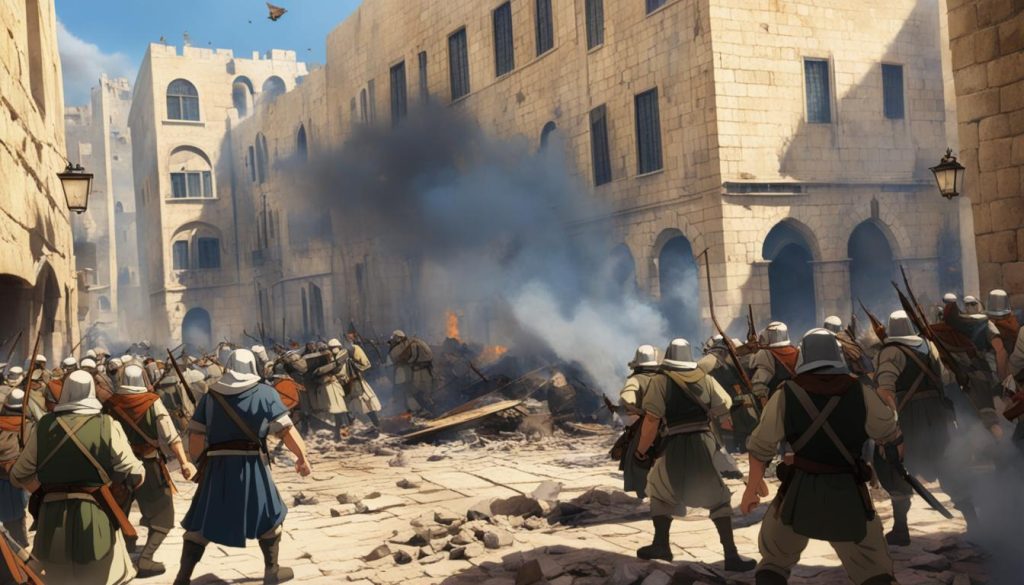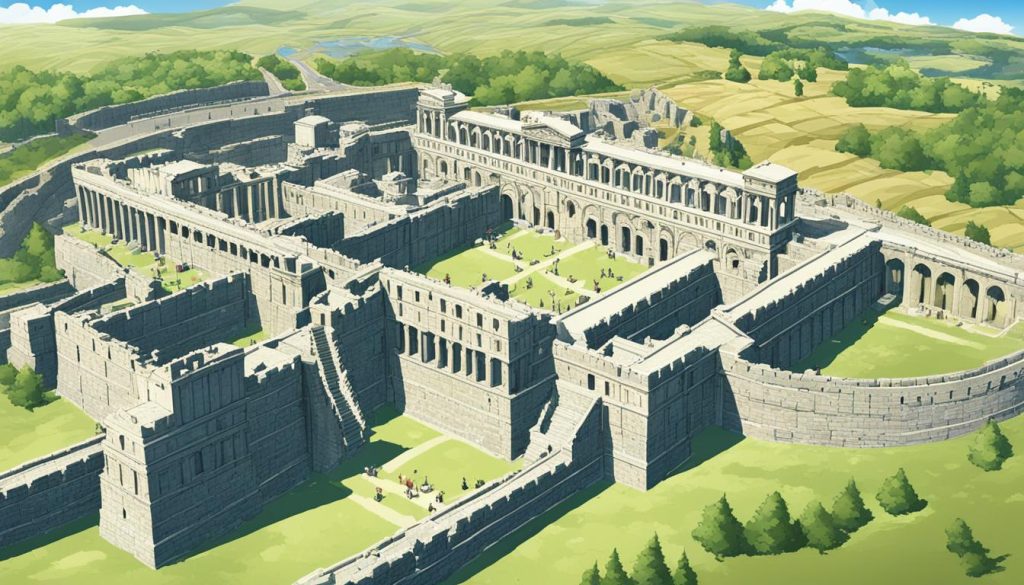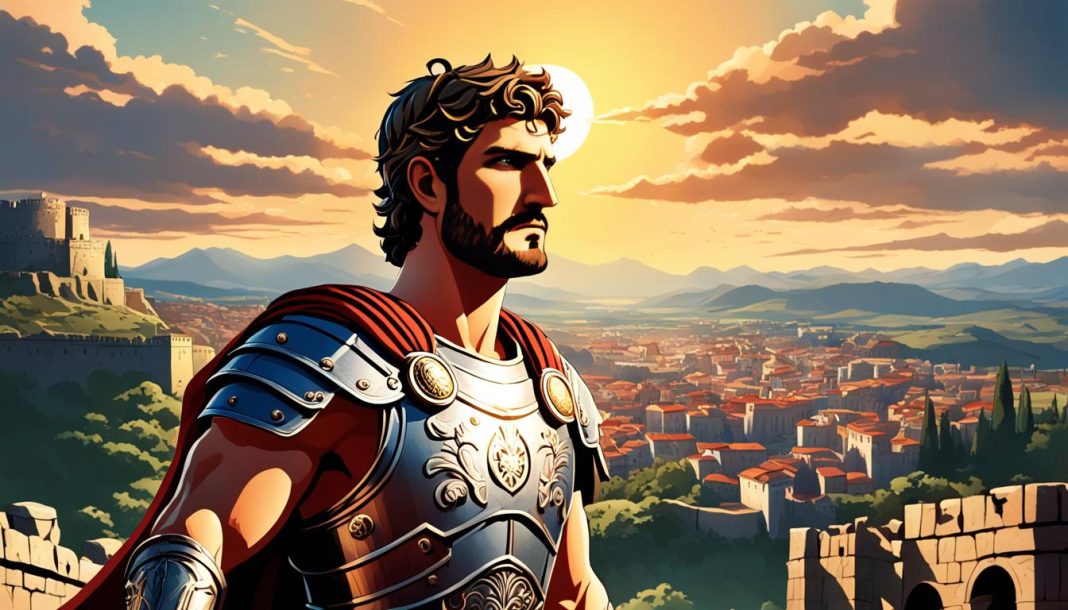
Hadrian, also known as Publius Aelius Hadrianus, was a Roman Emperor who ruled from 117 to 138 CE. His life and reign left a lasting impact on the Roman Empire and continue to be the subject of fascination and study to this day.
Imagine yourself transported back in time to the grandeur of Ancient Rome. The year is 117 CE, and the empire is under the rule of Trajan, a powerful and respected leader. As his reign comes to an end, a new emperor emerges onto the stage – Hadrian. A man of many talents and an insatiable thirst for knowledge, Hadrian soon establishes himself as a visionary leader, shaping the destiny of the Roman Empire.
Key Takeaways:
- Hadrian was a Roman Emperor who ruled from 117 to 138 CE.
- He was known for his architectural feats, such as the construction of the iconic Pantheon.
- Hadrian left a lasting impact on the Roman Empire through his cultural integration and military campaigns.
- His reign was marked by a strong connection to Greek culture and a complex relationship with his Jewish subjects.
- Hadrian is considered one of the Five Good Emperors of Rome.
Early Life and Rise to Power
Hadrian, born in Italica, Hispania Baetica (modern-day Andalusia, Spain), hailed from a lineage of Roman forebears. His father, originally from Italica, and his mother, a native of Gades (Cádiz), shaped Hadrian’s upbringing with influences from both provinces. After the untimely death of his father, Hadrian’s guardianship was entrusted to Trajan, his father’s cousin, and Acilius Attianus.
During his youth, Hadrian underwent military training, cultivating his skills and passion for hunting. These experiences laid the foundation for his later military endeavors and leadership. Following a conventional career path, Hadrian served as a military tribune, gradually ascending through the ranks and assuming various positions within the Roman Empire.
From Rome to Athens, Hadrian’s journey to power encompassed diverse territories and profound encounters that would shape his reign and legacy.
“The foundation of Hadrian’s future reign was established through his exposure to military training and his immersion in Roman traditions.”
Hadrian’s Architectural Legacy
One of Hadrian’s most significant architectural contributions was the construction of the Pantheon in Rome. The Pantheon, a well-preserved Roman monument, showcases a harmonious combination of Greek and Roman architectural elements. Featuring its iconic dome and impressive Corinthian columns, the Pantheon stands as a testament to the architectural brilliance of Hadrian’s era.
Another remarkable architectural feat of Hadrian was his countryside villa, a sprawling estate spanning seven square miles. Nestled amidst the scenic beauty of the countryside, Hadrian’s villa exemplified the grandeur and opulence of Roman architecture. It comprised palaces, gardens, libraries, thermal baths, and various other structures, each meticulously designed with intricate details that exemplify the magnificence of the Roman Empire.
Hadrian’s architectural legacy continues to inspire awe and admiration to this day. The Pantheon, with its breathtaking dome and timeless beauty, remains an iconic symbol of Rome’s architectural prowess. Similarly, Hadrian’s countryside villa stands as a testament to his vision and ability to create awe-inspiring structures that harmoniously blend with nature’s surroundings while showcasing the empire’s architectural achievements.
Hadrian’s Impact on Ancient Rome
Hadrian, as the Roman Emperor, played a pivotal role in unifying and consolidating the vast Roman Empire. His reign was marked by his diverse cultural scope and his efforts to promote the integration and harmony of the empire’s different regions and peoples.
One of Hadrian’s key areas of focus was the establishment of stable and defensible borders. He implemented strategic military campaigns and fortifications to protect the empire from external threats. Hadrian’s Wall, constructed in the northern frontier of Britannia, stands as a testament to his commitment to safeguarding Roman territories.
Furthermore, Hadrian recognized the immense cultural diversity within the Roman Empire and sought to foster unity through cultural integration. He embarked on extensive travels throughout the empire, immersing himself in the local customs, languages, and traditions. This firsthand exposure allowed him to understand the unique perspectives and needs of the regions under Roman rule.
Based on his experiences, Hadrian implemented policies that aimed to bridge cultural gaps and promote a sense of shared identity. He sponsored various public works projects, including the construction of temples, forums, and theaters, which showcased the artistic and architectural achievements of the empire.
Hadrian’s dedication to cultural integration extended beyond architectural projects. He also encouraged the adoption of Greek and Roman customs, education, and language across the empire, striving to create a cohesive and interconnected society.
“I consider it my duty as your emperor to foster unity and harmony among all citizens of the Roman Empire, regardless of their cultural or ethnic backgrounds. Let diversity be our strength, and let us strive to find common ground in our shared values and aspirations.”
Through his policies and personal commitment, Hadrian left an indelible mark on Ancient Rome. His focus on stability, cultural integration, and harmonious coexistence contributed to the empire’s longevity and served as a model for future emperors.
To visualize the grandeur of Hadrian’s architectural achievements, take a look at the Pantheon:
With its magnificent dome and impressive interior, the Pantheon is an iconic symbol of Hadrian’s architectural legacy and his commitment to the cultural scope of the Roman Empire.
Hadrian’s Relationship with Jewish Subjects
Hadrian’s relationship with the Jewish population in Judaea was volatile and marked by conflict. His attempts to Romanize the region and suppress Jewish customs and traditions ultimately led to a significant revolt known as the Bar Kokhba Revolt in 132 CE.
The Bar Kokhba Revolt was a violent resistance against Hadrian’s policies and the oppressive Roman rule. The Jewish population, led by Simon bar Kokhba, fiercely fought against the Roman authorities in an attempt to regain control of their homeland.
Hadrian, determined to quell the rebellion, responded with a scorched-earth campaign that devastated Judaea. His forces destroyed numerous Jewish towns and villages, including the capital city, Jerusalem. The Roman army’s brutal tactics resulted in widespread loss of life and the displacement of many Jewish people.
In addition to military action, Hadrian enacted laws aimed at suppressing Judaism and punishing the Jewish population. These laws included prohibitions on religious practices, such as the study of Torah and the observation of Jewish holidays. The aim was to eradicate Judaism and assimilate the Jewish population into Roman culture.
“Hadrian’s policies in Judaea were deeply oppressive and sparked a vehement response from the Jewish people.”
The consequences of Hadrian’s actions were far-reaching. The Bar Kokhba Revolt was eventually crushed by the Roman forces, and Judaea was completely reshaped. The region was renamed Syria Palaestina, erasing any Jewish connection, and Jerusalem was rebuilt as a Roman city.
Hadrian’s relationship with his Jewish subjects exemplifies the challenges faced by different cultures under Roman rule. It serves as a testament to the resilience and determination of the Jewish people in defending their identity and autonomy against oppressive forces.
Hadrian’s Greek Influence
Hadrian, known for his profound admiration for Greek culture, immersed himself in the vibrant and rich intellectual world of Athens even before ascending to the throne of the Roman Empire. His love for Greek culture was not confined to mere intellectual pursuits, but also manifested in his extensive patronage of public works projects in Athens, leaving an indelible mark on the city.
Hadrian’s generous support enabled the construction of magnificent buildings that stood as testaments to the enduring influence of Greek architecture. His commitment to the preservation and celebration of Greek culture can be seen in the construction of Greek-inspired buildings, adorned with iconic columns, intricate sculptures, and elaborate frescoes.
One of Hadrian’s most notable projects was the establishment of the Panhellenion, a commonwealth of Greek states that aimed to foster unity and cooperation among the Greek peoples. This initiative not only reinforced the ties between Rome and Greece but also provided a platform for the exchange of ideas, art, and culture.
Hadrian’s philhellenism extended beyond architectural endeavors. His portraiture, characterized by his long hair and tightly trimmed beard, reflected his embrace of the Greek aesthetic. This style was in stark contrast to the traditional clean-shaven appearance of Roman emperors, further emphasizing his affinity for Greek culture.
The impact of Hadrian’s Greek influence extended beyond Athens. In Rome, he granted equal representation to Greeks, recognizing their cultural contributions and integrating them into the diverse fabric of the empire. This inclusive approach was instrumental in promoting cultural assimilation and fostering a sense of unity among the various peoples under Roman rule.
“Hadrian’s commitment to Greek culture is a testament to his visionary leadership and his appreciation for the cultural legacy of our ancient predecessors.”
Hadrian’s Personal Life and Relationships
Hadrian, the Roman Emperor, had a complex personal life and diverse relationships that shaped his reign. His marriage to Vibia Sabina, Trajan’s grandniece, was reportedly unhappy and childless. However, it was not uncommon for Roman men of the time to have male lovers, and Hadrian was no exception.
One of his most notable and enduring relationships was with a young Bithynian named Antinous. Antinous accompanied Hadrian on his travels and was deeply valued by the emperor. Tragically, Antinous met an untimely death, which deeply affected Hadrian.
“Love demands sacrifice, and I would give anything to bring back my beloved Antinous.”
In commemoration of Antinous, Hadrian established a widespread cult and had statues erected, immortalizing him as a god. This testament of love and devotion speaks to the profound impact Antinous had on Hadrian’s life.
Hadrian’s personal life and relationships, including his marriage to Vibia Sabina and his profound connection with Antinous, offer a deeper understanding of the complexities and nuances of the Roman Emperor’s character.
Hadrian’s Later Life and Reign
During his later years, Hadrian faced chronic illness but remained active in his duties as emperor. He continued to travel throughout the empire, overseeing various projects and initiatives that left a lasting impact on the Roman Empire.
One of the major undertakings during this period was the completion of the iconic Pantheon, a Roman temple dedicated to all the gods. The Pantheon stands as a testament to Hadrian’s architectural vision and expertise, showcasing the fusion of Greek and Roman influences in its design and construction.
In addition to architectural endeavors, Hadrian faced a significant challenge in the form of the Bar Kokhba revolt. This Jewish revolt, which took place in Judaea from 132 to 136 CE, aimed to resist Hadrian’s attempts to suppress and Romanize the Jewish population. Despite the rebellion’s fierce resistance, Hadrian eventually managed to quell the revolt through a scorched-earth campaign.
Throughout his reign, Hadrian displayed a deep appreciation for Greek culture and sought to foster its influence within the Roman Empire. He dedicated himself to further promoting the cultural integration of the empire, including granting equal representation to Greeks in Rome and supporting public works projects in Athens.
Hadrian’s later life and reign were characterized by his determination to leave a lasting impact on the Roman Empire. Despite his chronic illness, he remained active and dedicated to his duties, overseeing the completion of monumental projects like the Pantheon and addressing challenges such as the Bar Kokhba revolt. Hadrian’s commitment to Greek culture and his military campaigns solidified his legacy as one of the most influential and enigmatic emperors in Roman history.
Hadrian’s Legacy and Historical Assessment
Hadrian, one of Rome’s Five Good Emperors, left a lasting legacy on the ancient world. Known for his leadership and accomplishments, Hadrian’s reign had a profound impact on Ancient Rome. However, he remains an enigmatic and contradictory figure, characterized by a unique blend of personal generosity and cruelty.
One of Hadrian’s most significant contributions was his dedication to architectural achievements. From the iconic Pantheon in Rome to his countryside villa, Hadrian’s architectural prowess showcased the grandeur and innovation of the Roman Empire.
Moreover, Hadrian’s reign was marked by his commitment to cultural integration. His extensive travels throughout the provinces allowed him to understand the diverse peoples under Roman rule. Through his policies and initiatives, Hadrian fostered unity and harmony, transcending cultural boundaries.
The historical assessment of Hadrian portrays him as a benevolent dictator, with his leadership encapsulating both impressive feats and complex contradictions. His enigmatic nature continues to captivate historians and scholars, as they uncover the multifaceted legacy he left behind.
Image:

Conclusion
Hadrian’s legacy in the Roman Empire is undeniable. As a Roman Emperor, he left a lasting impact on the empire through his architectural achievements, cultural integration efforts, and consolidation of Roman power. The Pantheon and Hadrian’s Wall stand as testaments to his dedication to the grandeur and unity of the empire.
Despite controversies and tensions, Hadrian is remembered as a significant figure in Roman history. His reign marked a period of stability and prosperity, and he is recognized as one of the most influential emperors of his time. His architectural projects not only showcased his vision for the empire but also served practical purposes, such as defense and infrastructure development.
Historical assessments of Hadrian vary, depicting him as an enigmatic and contradictory figure. While he was celebrated as a benevolent dictator, his acts of personal generosity were sometimes juxtaposed with instances of cruelty. Nevertheless, Hadrian’s impact on Ancient Rome is enduring, and his legacy continues to fascinate historians and archaeologists.
Thanks For Reading…Explore the Life and Reign of Hadrian
How much did you like Explore the Life and Reign of Hadrian? Please share your views in the comment box. Also, please share this story with your friends on social media so they can enjoy it, and for more such stories, please bookmark storiespub.com.
Check out other stories that we have:
























